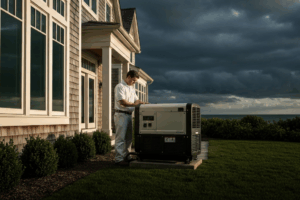What Are the Rules for Working on Energized Electrical Equipment?
Introduction
Working on Energized Electrical Equipment is a high-risk task for licensed electricians, permitted only as a last resort under strict NFPA 70E rules. De-energizing circuits is the default to prevent shocks, arc flashes, and injuries. This guide details NFPA 70E compliance, safety protocols, and procedures for live work, ensuring electricians mitigate hazards while adhering to industry standards.
The Justification for Working on Energized Electrical Equipment
NFPA 70E 130.2(A) allows energized work only when:
- De-energizing creates greater hazards: Shutting down power may disrupt critical systems like life-support equipment or emergency ventilation (e.g., hospital ICU circuits).
- De-energizing is infeasible: Tasks like voltage testing for troubleshooting require live circuits (e.g., diagnosing a control panel fault).
Convenience or time savings are never valid reasons. Proper justification ensures safety and compliance.
Ensuring Safety When Working on Energized Electrical Equipment
Following NFPA 70E protocols mitigates risks, ensuring safe, compliant practices for electricians handling energized systems.
Key Safety Protocols and Procedures
Step 1: Energized Electrical Work Permit
Obtain a permit per NFPA 70E 130.2, documenting the task, justification, risk assessment, and PPE requirements. Example: Testing a 480V panel requires a permit specifying voltage measurements and arc flash hazards.
Step 2: Hazard Identification and Risk Assessment
Conduct:
- Arc Flash Risk Assessment: Calculate the arc flash boundary and incident energy (NFPA 70E 130.5). Example: A 480V panel may have a 4-foot boundary with 8 cal/cm² energy, requiring Category 2 PPE.
- Shock Hazard Analysis: Identify limited (e.g., 3 feet for 120V) and restricted (e.g., 1 foot) approach boundaries (NFPA 70E 130.4).
Step 3: Personal Protective Equipment (PPE)
Wear:
- Arc-rated clothing/suits (e.g., 8 cal/cm² shirt for Category 2 hazards, NFPA 70E 130.7).
- Insulated gloves (e.g., Class 00 for ≤500V).
- Arc-rated face shield and safety glasses.
- Dielectric footwear.
Step 4: Insulated Tools and Equipment
Use insulated tools (e.g., screwdrivers for receptacle work), mats, blankets, and temporary grounds rated for the voltage (NFPA 70E 130.7(D)). Install temporary barriers to limit access (130.7(E)).
Complying with NFPA 70 and NFPA 70E Standards
Adhering to NFPA 70 and NFPA 70E ensures safe electrical practices, from installation to energized work, protecting electricians and facilities.
Adherence to Industry Standards
- NFPA 70 (NEC): Governs installations, including wire ampacity charts for conductor sizing and tying cables to avoid strain (NEC 300.4, 300.11).
- NFPA 70E: Defines safe work practices (110.3), approach boundaries (130.4), and permits (130.2). The accessible definition (NFPA 70E 100) ensures equipment access, while approach boundaries set safe distances.
- Arc Flash Labeling: Equipment must display arc flash boundaries and incident energy (NFPA 70E 130.5(H)).
Conclusion
Working on energized electrical equipment demands strict adherence to NFPA 70E, with de-energizing as the default. Permits, risk assessments, PPE, and insulated tools mitigate risks. By following NFPA 70 and NFPA 70E standards, electricians ensure safe, compliant practices, protecting themselves and others from electrical hazards.
Take the next step in your professional growth! Visit Expert CE (https://expertce.com/) for all your continuing education needs.
Continuing Education by State
Select your state to view board-approved continuing education courses and requirements:
Disclaimer: The information provided in this educational content has been prepared with care to reflect current regulatory requirements for continuing education. However, licensing rules and regulations can vary by state and are subject to change. While we strive for accuracy, ExpertCE cannot guarantee that all details are complete or up to date at the time of reading. For the most current and authoritative information, always refer directly to your state’s official licensing board or regulatory agency.



